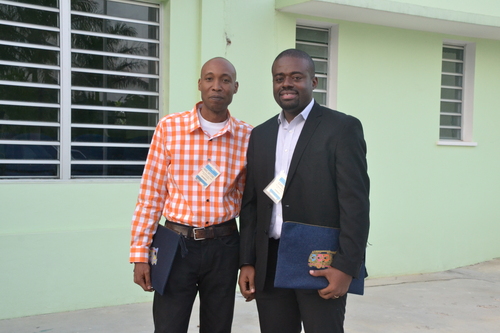Study Shows Promising Long-Term Results of Antiretroviral Therapy in Haiti
By CLAYTON LAUPUS Feb 23, 2016
 Dr. Jean-Juste and Dr. Samuel Pierre
Dr. Jean-Juste and Dr. Samuel Pierre
The New England Journal of Medicine recently published a paper by Weill Cornell Medicine investigators titled “10-Year Survival of Patients with AIDS Receiving Antiretroviral Therapy in Haiti”. Samuel Pierre, M.D. a doctor at GHESKIO in Haiti and a graduate student at Weill Cornell and Margaret McNairy, M.D. who is currently an assistant Professor of Medicine at Weill Cornell Medical College were two of the main researchers involved in this paper. The paper reported 10-year survival rates of the first patients to be treated with free AIDS drugs under PEPFAR (the United States President’s Emergency Plan for AIDS Relief). The reported 10-year survival rate was approximately 70% and is comparable to rates in the United States.
In his 2003 State of the Union Address, President George W. Bush proposed the Presidents Emergency Plan for AIDS Relief (PEPFAR). PEPFAR’s goal was to prevent seven million new HIV infections, treat at least two million people with Antiretroviral Therapy (ART), and provide care to 10 million people suffering from AIDS and for children who had lost one of both parents to AIDS. PEPFAR has provided more than $60 billion in funding over five years to the Global Fund to Fight AIDS, Tuberculosis, and Malaria; and bilateral tuberculosis programs. 13 years later with increased funding, there are currently 9.5 million people receiving life-saving antiretroviral treatment and more than 68.2 million people who have had access to HIV testing and counseling, all due to PEPFAR.
GHESKIO was the earliest clinic to receive PEPFAR funding and access to ART in 2004. The recently published paper offers an update on the first thousand patients treated at GHESKIO who were also some of the first people to receive ART under PEPFAR. The paper reports, “The 10-year survival rate estimate of 63 to 71 percent in one of the first large cohorts of patients receiving ART in the developing world is similar to that among patients in the early era of ART in the United States.” These results offer an optimistic view on what can be achieved over the long-term if international efforts to provide ART in these resource-poor scenarios are continued. “Achieving such high 10-year survival in AIDS patients despite abject poverty, political instability, and lack of infrastructure in Haiti tell us that sustainable HIV programs in resource-poor countries are feasible” said Dr. McNairy.
To date, PEPFAR has allowed for a drastic increase in access to AIDS treatment for resource poor settings such as the Caribbean and sub-Saharan Africa. The outcomes were similar to those found in the United States when initial treatment with ART began which shows promise for the future of treatment in the developing world. As the paper suggests as long as international support continues, the rate of survival in the developing world should trend towards the rate of survival in the developed world.
Weill Cornell Medicine Center for Global Health
Center for Global Health
420 East 70th Street, 4th Floor, Suite LH-455
New York, NY 10021
Phone: (646) 962-8140
Fax: (646) 962-0285

